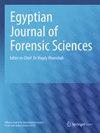适用于巴西成年人的 Kvaal 牙齿年龄估算法--有效性横断面测试
IF 1.3
Q3 MEDICINE, LEGAL
引用次数: 0
摘要
成年人的牙齿年龄估计是法医牙科学中一项具有挑战性的程序。自上世纪 90 年代以来,X 射线照相技术已经能够对成年人进行非侵入性的年龄估计。Kvaal 基于次生牙本质沉积的方法已在多个人群中得到广泛应用。然而,在南美洲,使用这种方法进行的针对特定人群的研究却很少。本研究在巴西成年人的 X 光片样本中测试了 Kvaal 方法的有效性。样本包括 192 张根尖周 X 光片,其中 106 名女性(55.2%)和 86 名男性(44.8%)的年龄在 20 至 80 岁之间。根据 Kvaal 方法评估了上颌右侧(84 人,占 43.8%)和左侧(108 人,占 56.2%)永久中切牙。估计年龄(EA)与年代年龄(CA)之间的林氏一致系数为 0.800(IC95% = 0.753; 0.847)(P < 0.001)。EA 与 CA 之间的平均年龄差为 - 2.84 岁(p < 0.001)。就女性和男性而言,EA 和 CA 之间的平均差异分别为 - 3.82 年 (CI95% = - 5.38; - 2.25) (p < 0.001) 和 - 1.86 年 (CI95% = - 3.56; - 0.17) (p = 0.031)。低估是主要现象,并随着时间的推移而增加。在最初发表 28 年后的今天,Kvaal 的方法对于成人非侵入性牙齿年龄估计仍然是可靠的,尤其是在分析巴西人的上颌恒中切牙时。本文章由计算机程序翻译,如有差异,请以英文原文为准。
Kvaal’s dental age estimation method applied to Brazilian adults—a cross-sectional test of validity
Dental age estimation of adults is a challenging procedure in forensic odontology. Radiographic techniques have enabled non-invasive age estimation of adults since the 90’s. Kvaal’s method based on the deposition of secondary dentin has demonstrated broad applicability in several populations. Population-specific studies with this method, however, are scarce in South America. This study tested the validity of Kvaal’s method in a sample of radiographs of Brazilian adults. The sample consisted of 192 periapical radiographs of 106 females (55.2%) and 86 males (44.8%) with ages between 20 and 80 years old. The permanent maxillary right (n = 84, 43.8%) and left (n = 108, 56.2%) central incisors were assessed based on Kvaal’s method. Lin’s coefficient of concordance between estimated (EA) and chronological (CA) ages was 0.800 (IC95% = 0.753; 0.847) (p < 0.001). The mean difference between EA and CA was − 2.84 years (p < 0.001). For females and males, separately, the mean differences between EA and CA were − 3.82 years (CI95% = − 5.38; − 2.25) (p < 0.001) and − 1.86 years (CI95% = − 3.56; − 0.17) (p = 0.031), respectively. Underestimations were predominant and increased with time. After 28 years of the original publication, Kvaal’s method remains reliable for non-invasive dental age estimation of adults, especially for the analysis of the permanent maxillary central incisors of Brazilian individuals.
求助全文
通过发布文献求助,成功后即可免费获取论文全文。
去求助
来源期刊

Egyptian journal of forensic sciences
MEDICINE, LEGAL-
CiteScore
2.00
自引率
0.00%
发文量
51
审稿时长
17 weeks
期刊介绍:
Egyptian Journal of Forensic Sciences, the official publication of The International Association of Law and Forensic Sciences (IALFS), is an open access journal that publishes articles in the forensic sciences, pathology and clinical forensic medicine and its related specialities. The journal carries classic reviews, case studies, original research, hypotheses and learning points, offering critical analysis and scientific appraisal.
 求助内容:
求助内容: 应助结果提醒方式:
应助结果提醒方式:


